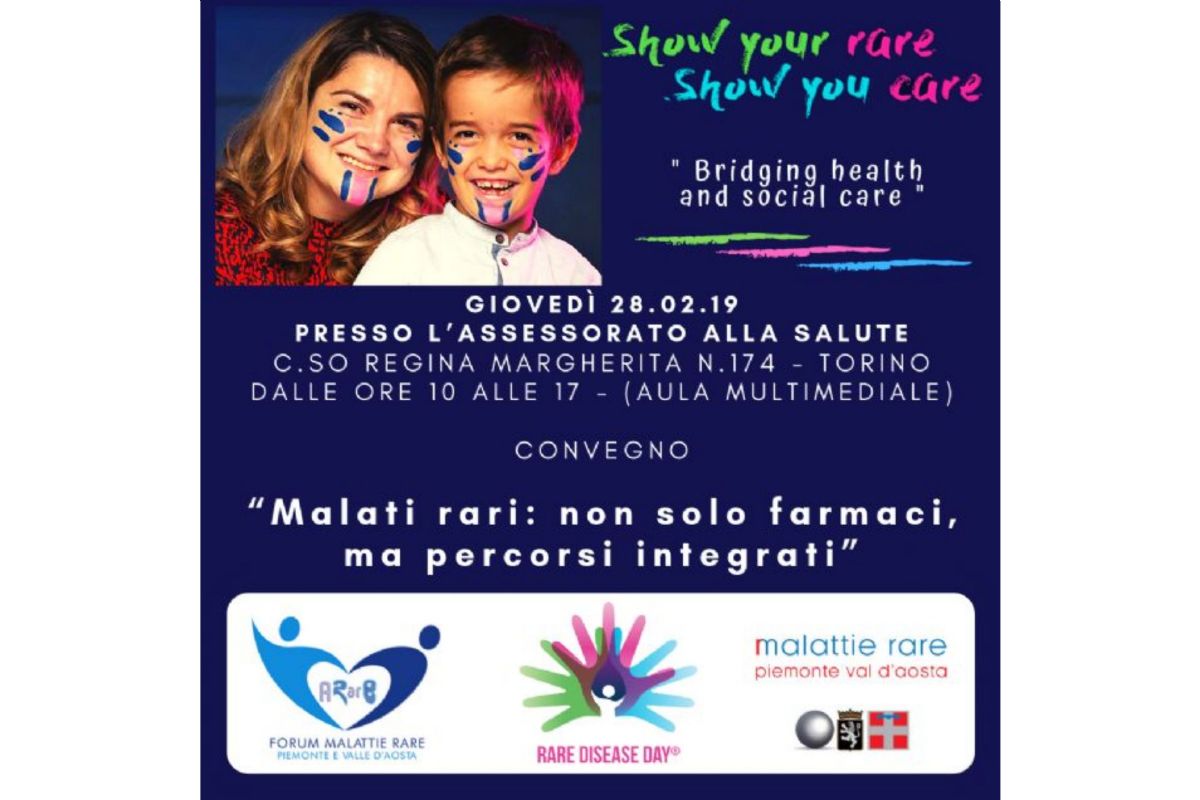Interregional Rare Diseases Network
Piedmont and Valle d'Aosta
recent news
 16/12/2021 News
16/12/2021 News10th Undiagnosed Diseases Network International Conference
Torino (Italy) 31 January - 1 February 2022 - A Hybrid event Host: Dario Roccatello University of Torino (Italy)
 18/05/2020 News
18/05/2020 NewsWebinar “L’impegno delle Regioni per le malattie rare in tempo di pandemia da COVID-19”
Webinar ISS-Covid-19
 23/02/2019 Events
23/02/2019 EventsRare patients: not only drugs but integrated paths, meeting in Turin on the occasion of World Rare Disease Day
On the occasion of World Rare Disease Day, Thursday 28 February in Turin at the Multimedia Room of the Region, c.so Regina Margherita 173, a meeting will be held open to all interested parties.
Information for patients
If you, a relative of yours, a friend of yours are suffering from a rare disease, you can look up information about the Piedmont and Valle d'Aosta care network and the rights you can access in the various sections of the site.
In particular you can find information related to the legislative support both of health and social-welfare and social security, to the diagnostic and assistance offer of the Health Authorities, the Hospitals and the Scientific Research and Treatment Institutes (IRCCS) of the Piedmont regions and Valle d'Aosta and the voluntary associations specifically addressed to the problem of rare diseases.
If you are looking for information on a specific rare pathology, you can consult the brief descriptions on the site.
Information for operators
If you are an operator dealing with patients suffering from a rare disease or where there is a suspicion of a rare disease, you can find information on this site about:
- The legislation underlying the network activities for rare diseases;
- What diagnostic and assistance offers the Interregional network for rare diseases offers in order to correctly address the patient;
- Which genetic tests are carried out in Piedmont and Valle d'Aosta and at which centers it is possible to perform them;
- Which are the consortium activities activated by the interregional network, what are the aims of the single activities which are the contact persons to contact in order to be able to join the activities of the consortium;
- How the patient with a diagnosis or suspected rare disease can access the exemption;
- What are the criteria for the exemption) established by the Piedmont Region for some pathologies or groups of pathologies;
- What types of drugs (and dietary aids) can be used to treat patients with rare diseases based on current legislation and what are the ways to deliver them;
- Which are the voluntary associations to which patients suffering from rare disease can address.
If you are looking for information on a specific rare pathology, you can consult the brief descriptions available on the site. To obtain more detailed information about any rare disease (and not just those exempted), you can consult the Orphanet website, the European portal for rare diseases and orphan drugs.
If you do not find the information you need, you can contact the Coordination Center of the Interregional Network for Rare Diseases of Piedmont and Valle d'Aosta (CMID) by calling +39 011 2402127 (Monday to Friday from 9.00 to 17.00) or you can send an email to: info@malattierarepiemonte.it
Patient associations and volunteering
This is the new institutional site of the Interregional Network for Rare Diseases of Piedmont and Valle d'Aosta .
The network is made up of health professionals who deal with patients suffering from rare diseases and has the purpose of improving care through a multidisciplinary commitment and a diffusion of specific knowledge related to rare diseases.
Who this site is for
This site aims to be an aid to patients , their families , members of associations , health and social workers dealing with the world of rare diseases.
What are rare diseases
Rare illness means a disease affecting less than 5 out of 10,000 people in the European Community.
The World Health Organization (WHO) estimates that there are between 6,000 and 8,000 different rare diseases and that around 10% of the world's population is affected by some rare disease.
The rarity of these pathologies means that the patients who are affected experience greater problems than patients suffering from common pathologies and due to diagnostic difficulties and the lack of information even among health professionals, both due to the lack of therapeutic options , above all pharmacological, and to the emotional impact and the experience of isolation afflicting patients and their families.
In addition to these characteristics, these are often diseases that threaten life or are chronically debilitating .
To address this group of diseases, a particular joint effort , specific knowledge and widespread information are needed.
In Italy, Ministerial Decree 279 of 2001 sought to provide the first concrete answers to patients suffering from rare diseases. In particular:
1) identified 341 diseases or groups of rare diseases considered worthy of exemption from health care costs for benefits included within the Essential Levels of Assistance (LEA). In 2005 and 2007 first the Piedmont Region and subsequently the Valle d'Aosta Region extended the exemption to other 40 pathologies ( NB: these pathologies are exempted only in Piedmont and Valle d'Aosta );
2) identified the characteristics necessary for the realization of the national network for the prevention, surveillance, diagnosis and therapy of rare diseases . The Piedmont Region and the Valle d'Aosta Region subsequently implemented the Decree by first establishing two separate Networks and, starting in 2008, an interregional Network for Rare Diseases of Piedmont and Valle d'Aosta ;
3) established a national register of rare diseases in which to record all cases of patients suffering from rare disease based at the National Institute of Health ;
Interregional network activities for rare diseases in Piedmont and Valle d'Aosta
Since April 2008, the Regions of Piedmont and Valle d'Aosta have established a single catchment area and, in association, have established an interregional coordination center for rare diseases and jointly created an interregional register for rare diseases .
The interregional network for Rare Diseases has been designed to develop an assistance model that, guaranteed the quality of diagnostic performance , also of genetic type , at institutions of excellence , favored the taking in charge of the patient in the territorial structures closest to the place of residence.
The Interregional Network of Rare Diseases of the Piedmont and Valle d'Aosta emerging as a unique experience in Italy , based on the principles of decentralization , is intended to optimize the accessibility of patients to treatment and is governed by assistance consortia that elaborate, for related disease groups, shared diagnostic and therapeutic protocols for optimal and uniform patient management in the territory.
The activity of the interregional network for rare diseases in Piedmont and Valle d'Aosta is described in detail in the attached document .
